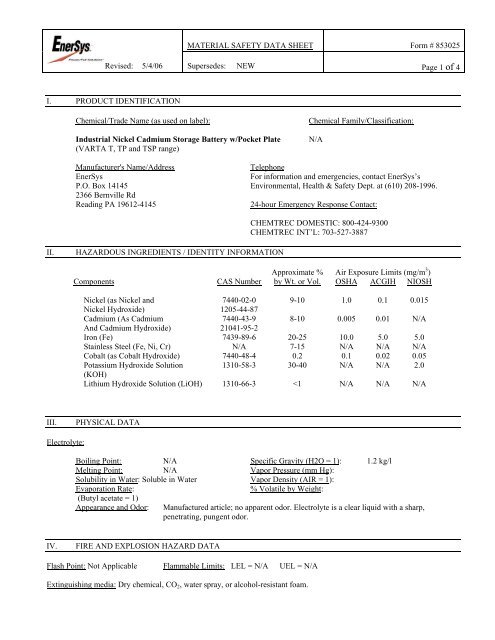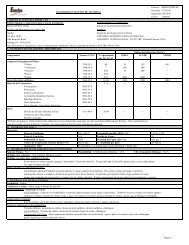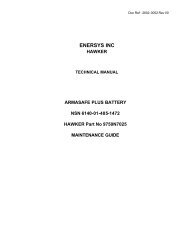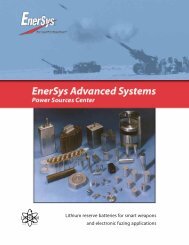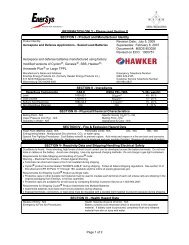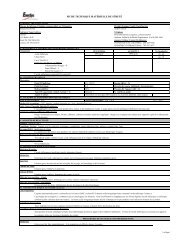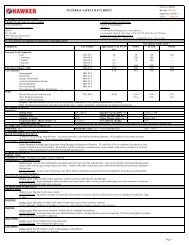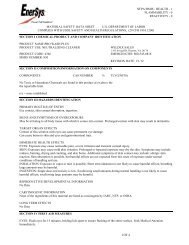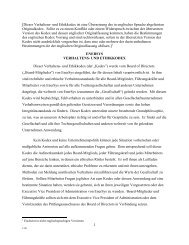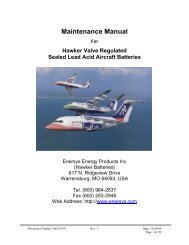MATERIAL SAFETY DATA SHEET Form # 853025 Revised: 5/4/06 ...
MATERIAL SAFETY DATA SHEET Form # 853025 Revised: 5/4/06 ...
MATERIAL SAFETY DATA SHEET Form # 853025 Revised: 5/4/06 ...
You also want an ePaper? Increase the reach of your titles
YUMPU automatically turns print PDFs into web optimized ePapers that Google loves.
<strong>Revised</strong>:<br />
5/4/<strong>06</strong><br />
I. PRODUCT IDENTIFICATION<br />
<strong>MATERIAL</strong> <strong>SAFETY</strong> <strong>DATA</strong> <strong>SHEET</strong><br />
Supersedes:<br />
NEW<br />
Chemical/Trade Name (as used on label): Chemical Family/Classification:<br />
Industrial Nickel Cadmium Storage Battery w/Pocket Plate N/A<br />
(VARTA T, TP and TSP range)<br />
<strong>Form</strong> # <strong>853025</strong><br />
Manufacturer's Name/Address Telephone<br />
EnerSys For information and emergencies, contact EnerSys’s<br />
P.O. Box 14145 Environmental, Health & Safety Dept. at (610) 208-1996.<br />
2366 Bernville Rd<br />
Reading PA 19612-4145 24-hour Emergency Response Contact:<br />
II. HAZARDOUS INGREDIENTS / IDENTITY INFORMATION<br />
CHEMTREC DOMESTIC: 800-424-9300<br />
CHEMTREC INT’L: 703-527-3887<br />
Approximate % Air Exposure Limits (mg/m 3 )<br />
Components CAS Number by Wt. or Vol. OSHA ACGIH NIOSH<br />
Nickel (as Nickel and<br />
7440-02-0 9-10 1.0 0.1 0.015<br />
Nickel Hydroxide)<br />
1205-44-87<br />
Cadmium (As Cadmium<br />
7440-43-9 8-10 0.005 0.01 N/A<br />
And Cadmium Hydroxide)<br />
21041-95-2<br />
Iron (Fe) 7439-89-6 20-25 10.0 5.0 5.0<br />
Stainless Steel (Fe, Ni, Cr) N/A 7-15 N/A N/A N/A<br />
Cobalt (as Cobalt Hydroxide) 7440-48-4 0.2 0.1 0.02 0.05<br />
Potassium Hydroxide Solution<br />
(KOH)<br />
1310-58-3 30-40 N/A N/A 2.0<br />
Lithium Hydroxide Solution (LiOH) 1310-66-3
<strong>Revised</strong>:<br />
5/4/<strong>06</strong><br />
<strong>MATERIAL</strong> <strong>SAFETY</strong> <strong>DATA</strong> <strong>SHEET</strong><br />
Supersedes:<br />
NEW<br />
<strong>Form</strong> # <strong>853025</strong><br />
Page 2 of 4<br />
Special Fire Fighting Procedures: Use full body protective clothing and full facepiece. Self-contained breathing apparatus in a<br />
positive pressure mode. Molted and overheated Cd and Ni produce fume, vapor or dust. Under these conditions, Ni or Cd is<br />
suspected carcinogen. KOH is highly caustic. Contact with eye and skin must be avoided. No heating or smoking during<br />
handling or inspection. Do not cause sparks.<br />
V. REACTIVITY <strong>DATA</strong><br />
Stability: Stable X Conditions to Avoid: Avoid shorting batteries such as contacting across terminals<br />
Unstable ___ with any metal object. Avoid continuous temperatures over 190ºF.<br />
Hazardous Decomposition Products:<br />
Nickel compounds, Cadmium compounds, and caustic liquid.<br />
Incompatibility: (materials to avoid)<br />
Do not fill cells with Lead Acid Battery electrolyte (Sulfuric Acid).<br />
VI. HEALTH HAZARD <strong>DATA</strong><br />
Inhalation:<br />
Fumes irritate nose and throat but fumes generated only if batteries are on charge (not a transportation condition).<br />
Eye Contact:<br />
Severe irritation. Possible corneal damage. Flush with water for 15 minutes.<br />
Skin Contact:<br />
Severe irritation and inflammation. Flush with water. Obtain medical attention.<br />
Skin Absorption:<br />
Severe irritation and inflammation. Flush with water. Obtain medical attention.<br />
Ingestion:<br />
Severe inflammation or internal tissues. Contact physician immediately.<br />
FIRST AID<br />
Inhalation:<br />
Not applicable to batteries in transit but if on charge in confined poorly ventilated area and fumes irritating remove person to<br />
fresh air.<br />
Eyes:<br />
Hold eyelids open and flush with clean water for 15 minutes. Get medical help promptly.
Skin:<br />
<strong>Revised</strong>:<br />
5/4/<strong>06</strong><br />
<strong>MATERIAL</strong> <strong>SAFETY</strong> <strong>DATA</strong> <strong>SHEET</strong><br />
Supersedes:<br />
Remove contaminated clothing and flush skin with water for 15 minutes. Do not attempt to neutralize with alkaline.<br />
Ingestion:<br />
NEW<br />
Get medical help. Give patient copious amounts of water. Do not induce vomiting.<br />
VII. PRECAUTIONS FOR SAFE HANDLING AND USE<br />
Spill or Leak Procedures:<br />
<strong>Form</strong> # <strong>853025</strong><br />
Page 3 of 4<br />
Clean up personnel should wear safety goggles, rubber gloves, rubber boots and rubber apron. Use weak acids, ex: boric acid,<br />
acetic acid.<br />
Waste Disposal Methods:<br />
Consult waste disposal business for proper disposition. Do not empty in common sewer systems.<br />
Handling:<br />
Rubber boots and rubber aprons, chemical goggles or full-face shield should be worn.<br />
Storage:<br />
Cells/Batteries to be stored in standard battery room conditions.<br />
VIII. CONTROL MEASURES<br />
Personal Protective Equipment: Rubber gloves, safety goggles, alkaline resistant protective clothing.<br />
IX. OTHER REGULATORY INFORMATION<br />
IATA<br />
The international transportation of wet and moist charged (moist active) batteries is regulated by the International Air<br />
Transport Association (IATA). These regulations also classify these types of batteries as a hazardous material. The batteries<br />
must be packed according to IATA Packing Instruction 800. The shipping information is as follows:<br />
Proper Shipping Name: Batteries, wet, filled with alkali<br />
Hazardous Class: 8<br />
UN Identification: UN2795<br />
Packing Group: III<br />
Label / Placard Required: Corrosive<br />
IMDG<br />
The international transportation of wet and moist charged (moist active) batteries is regulated by the International Maritime<br />
Dangerous Goods code (IMDG). These regulations also classify these types of batteries as a hazardous material. The batteries<br />
must be packed according to IMDG code pages 8120 and 8121. The shipping information is as follows:
<strong>Revised</strong>:<br />
5/4/<strong>06</strong><br />
<strong>MATERIAL</strong> <strong>SAFETY</strong> <strong>DATA</strong> <strong>SHEET</strong><br />
Supersedes:<br />
Proper Shipping Name: Batteries, wet, filled with alkali<br />
Hazardous Class: 8<br />
UN Identification: UN2795<br />
Packing Group: III<br />
Label / Placard Required: Corrosive<br />
NEW<br />
Contact your EnerSys representative for additional informational regarding the classification of batteries.<br />
IX. OTHER REGULATORY INFORMATION (continued)<br />
RCRA: Spent nickel-cadmium batteries are regulated as universal waste by the EPA when recycled, however state and<br />
international regulations may vary.<br />
CERCLA (Superfund) and EPCRA:<br />
<strong>Form</strong> # <strong>853025</strong><br />
Page 4 of 4<br />
(a) EPCRA Section 312 Tier 2 reporting is required for batteries if potassium hydroxide, nickel and/or cadmium is present in<br />
quantities of 10,000 lbs. or more.<br />
(b) Supplier Notification: This product contains toxic chemicals, which may be reportable under EPCRA Section 313 Toxic<br />
Chemical Release Inventory (<strong>Form</strong> R) requirements. If you are a manufacturing facility under SIC codes 20 through 39, the<br />
following information is provided to enable you to complete the required reports:<br />
Toxic Chemical CAS Number Approximate % by Wt.<br />
Nickel 7444-02-0 9-10<br />
Cadmium 7440-43-9 8-10<br />
Cobalt 7440-48-4 0.2<br />
If you distribute this product to other manufacturers in SIC Codes 20 through 39, this information must be provided with the<br />
first shipment of each calendar year.<br />
The Section 313 supplier notification requirement does not apply to batteries, which are "consumer products".<br />
(c) TSCA<br />
Ingredients in EnerSys’s batteries are listed in the TSCA Registry as follows:<br />
Component CAS Number TSCA Status<br />
Nickel 7444-02-0 Listed<br />
Cadmium 7440-43-9 Listed<br />
Iron 7439-89-6 Listed<br />
Potassium Hydroxide 1310-58-3 Listed<br />
Cadmium Hydroxide 21041-95-2 Listed<br />
Cobalt 7440-48-4 Listed<br />
(d) CAA<br />
EnerSys supports preventative actions concerning ozone depletion in the atmosphere due to emissions of CFC’s and other<br />
ozone depleting chemicals (ODC’s), defined by the USEPA as Class I substances. Pursuant to Section 611 of the Clean Air Act<br />
Amendments (CAAA) of 1990, finalized on January 19, 1993, EnerSys established a policy to eliminate the<br />
use of Class I ODC’s prior to the May 15, 1993 deadline.


